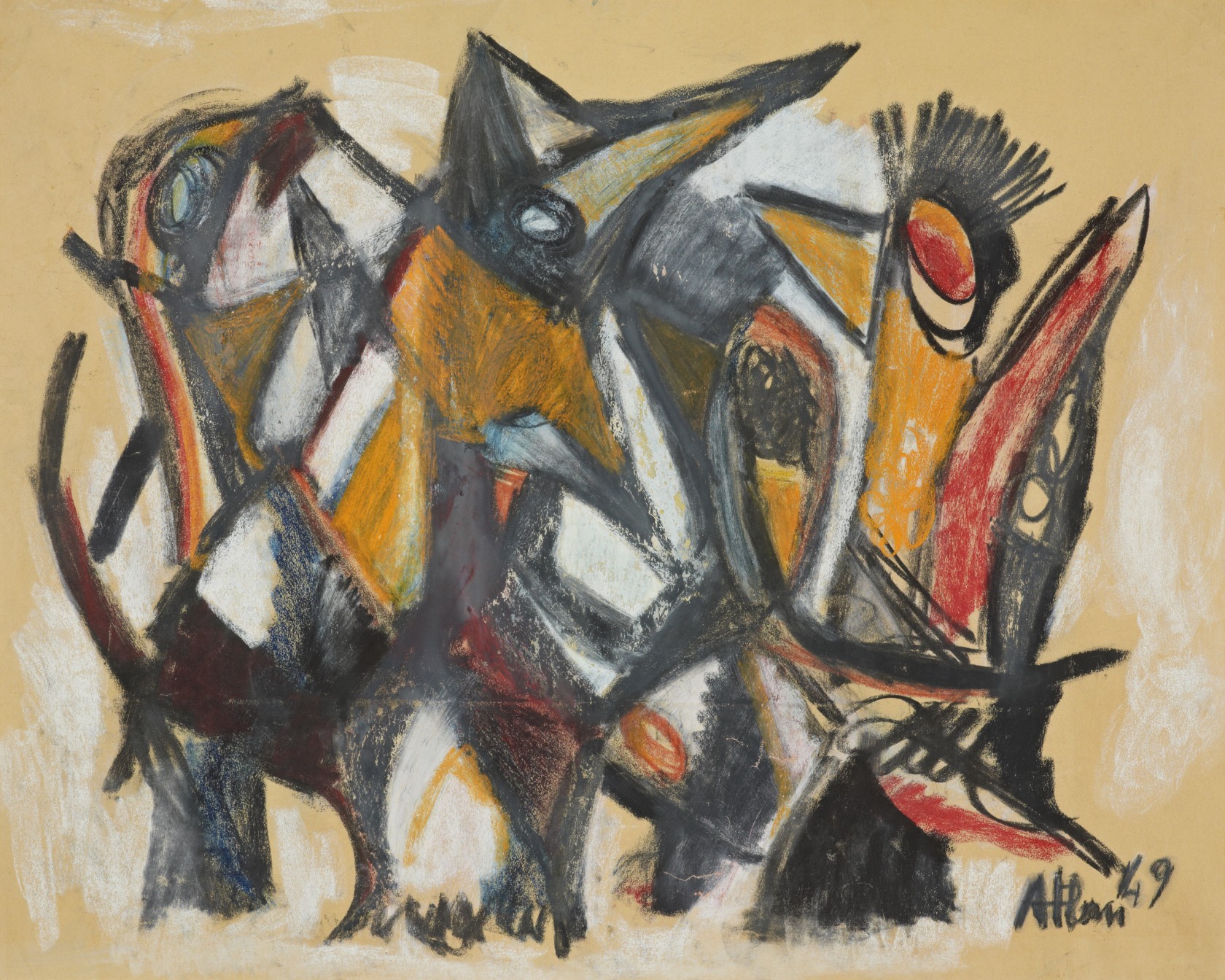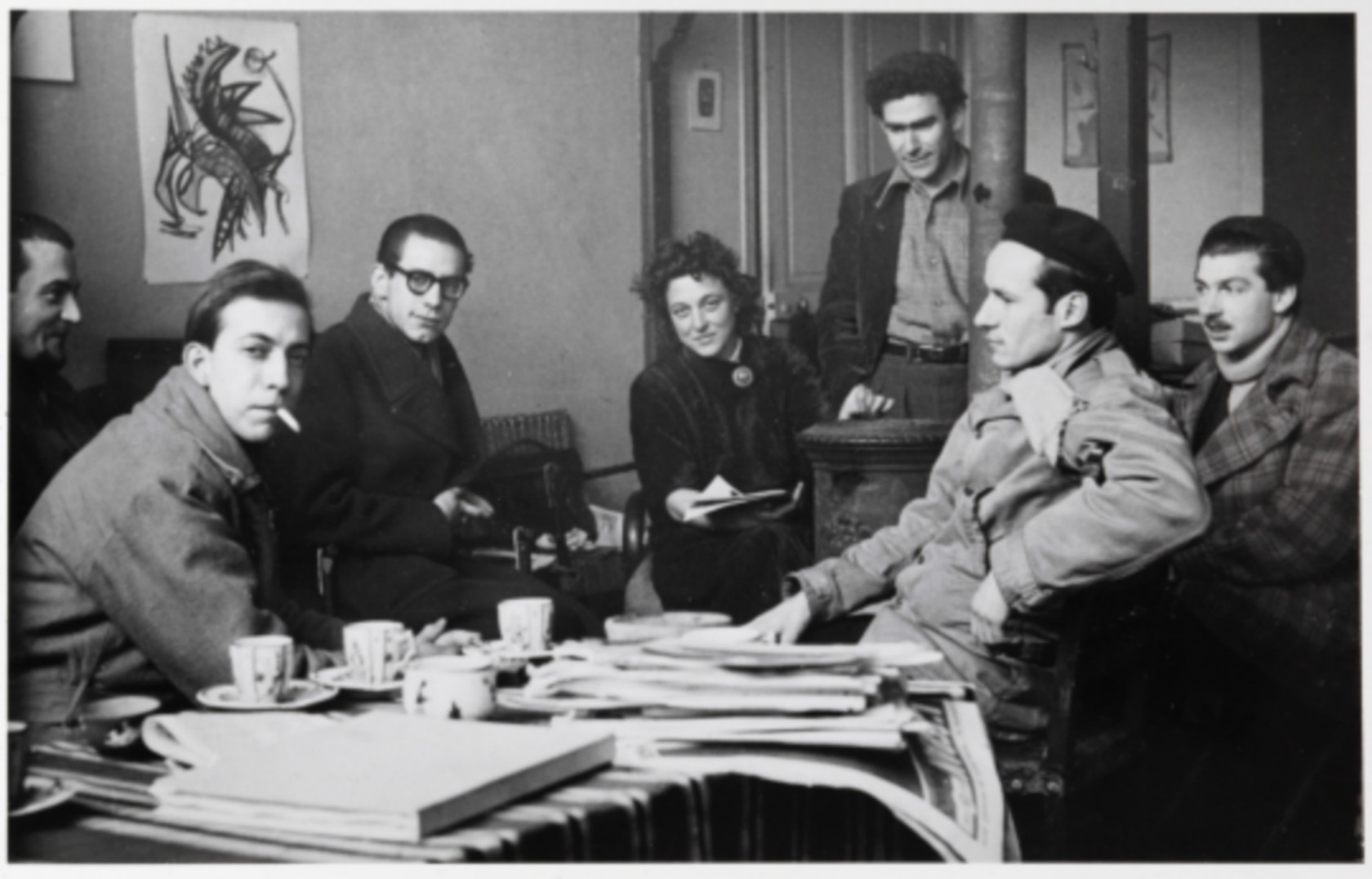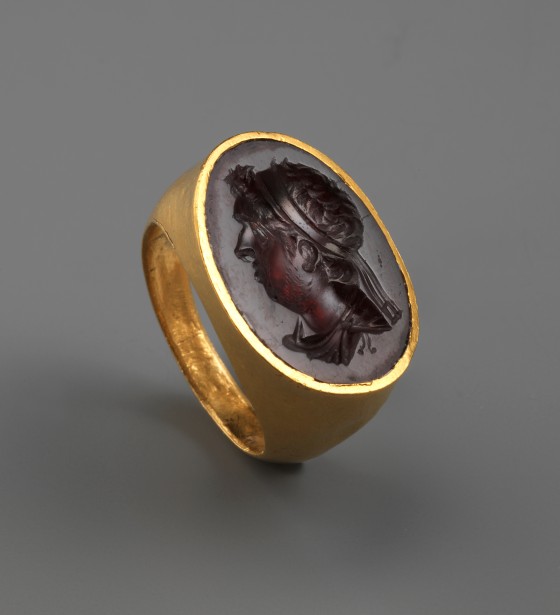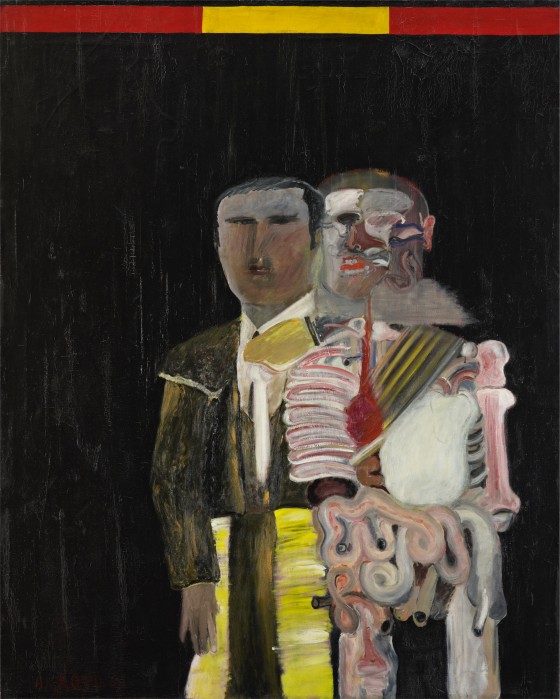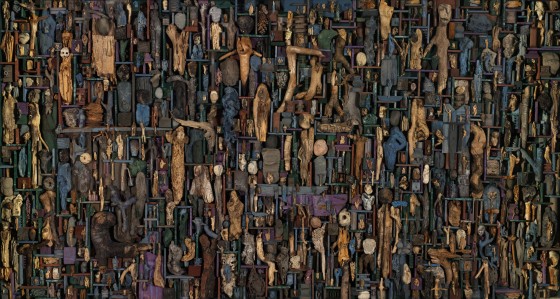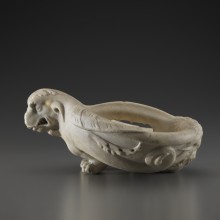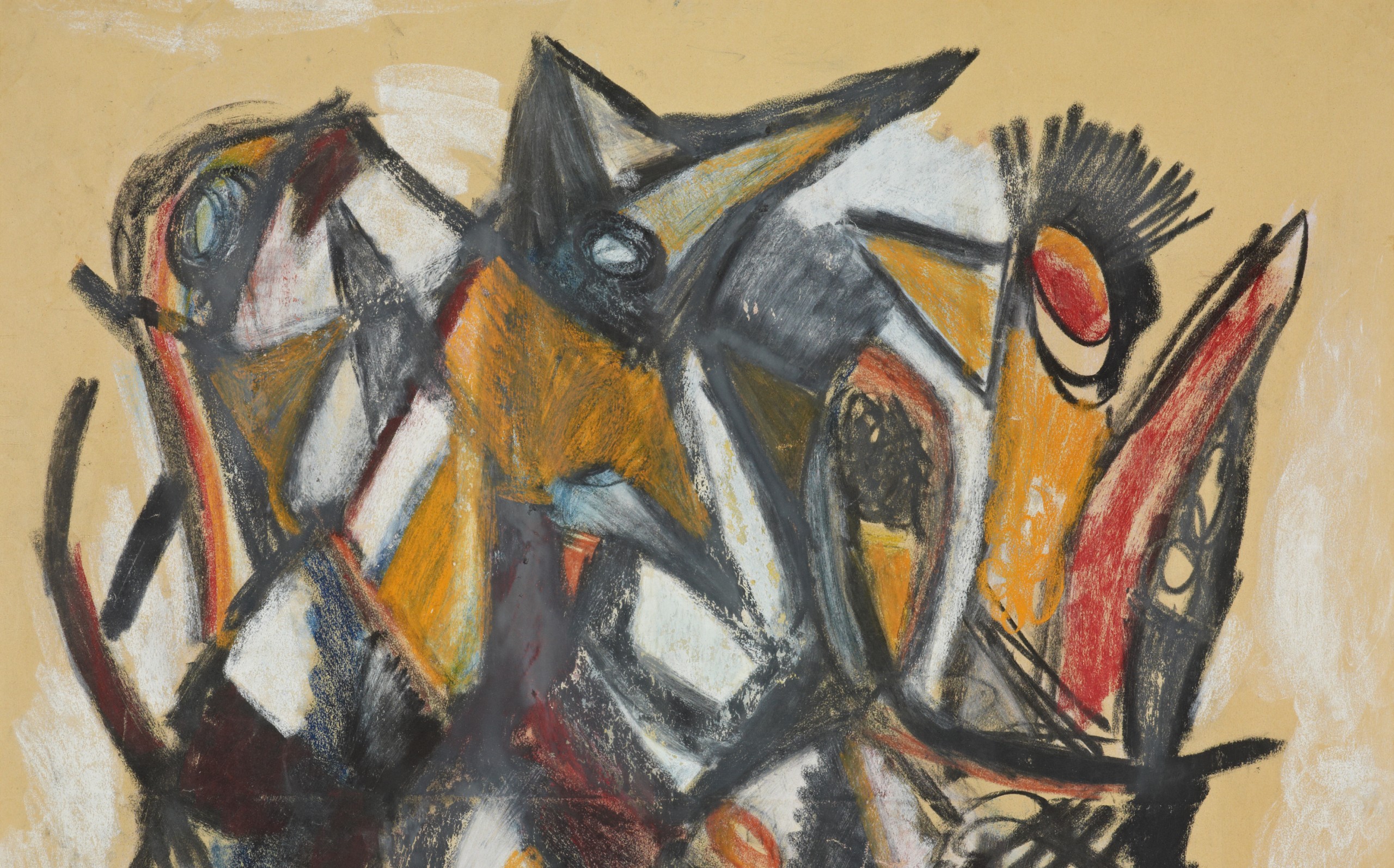
September 2021 Fine Arts
Atlan’s fantastic bestiary
Sans titre [Untitled], representative of the first period (1941-1954) in Jean-Michel Atlan's work, is strikingly spontaneous and rhythmic. It is part of a body of graphic work comprising around 800 artworks on paper in pastel, chalk and gouache1, representing nearly half the artist's output. This shows just how familiar he was with graphic techniques, appreciating their innumerable material qualities. He has restored to favour the art of pastel in modern art, proving to be an exceptional pastellist2, as shown by this example on paper from 1949.
See the artwork in the collectionJean-Michel ATLAN
(Constantine, 1913 - Paris, 1960)
Sans titre [Untitled]
1949
Pastel on paper
61.5 x 75 cm
FGA-BA-ATLAN-0007
Provenance
Mogens Fischer Collection, Denmark
Kunsthallen Kunstauktioner, Copenhagen, 1996, anonymous sale no. 470, lot 52
Private collection
Christie's, Paris, 9 December 2010, lot 110
Exhibitions
IIIe Hommage à Atlan, Copenhaguen, Salon Corner, 1982
The Liberation of Painting, 1945-1962, Caen, Caen Memorial Museum, 14.07.2020 – 31.01.2021
A Singular Destiny
In the aftermath of the Second World War, Atlan met with a certain amount of success. From 19413 to 1944 he began with a form of expressionist figuration, but the year 1945 was a turning point in the artist's work, as he then started to explore informal approaches. When he left the Sainte-Anne psychiatric hospital on the Liberation of Paris in 19444, having been committed there after feigning madness to escape execution, his creative desire was unshakeable. From that point on, he devoted himself entirely to painting. In 1947, he exhibited at the Maeght Gallery, placing himself immediately at the forefront of the art scene. The doors of Parisian salons and galleries were then open to him. His works joined prestigious collections such as that of poetess Gertrude Stein5. However, after breaking his contract with the Maeght gallery in 1948, he disappeared from the Parisian art scene and its fashions, only to be rediscovered in 19566. He was hungry for independence and freedom and rejected the label of "lyrical abstract" that critics tried to put on his work7. Abstract art prevailed nonetheless, but in a didactic and geometricising version. A period of penury then followed for Atlan.
The year 1949 corresponded to a time of doubt and material difficulties for the painter. His work continued to shock and surprise critics and art lovers. Sans titre [Untitled] attests to this period and to the evolution of Atlan's painting, who, despite the lack of interest from critics and the market, continued to assert his own artistic language.
The Birth of Form
This drawing, worked in oil pastel on paper, reflects his scarcity of means during those dark years when Jean-Michel Atlan rarely used oil paint. Encumbering himself with little detail, the artist produced his work in three stages: he first covered the paper’s whole surface with yellow ochre pastel, then worked by rubbing with the entire body of the pastel pencil to create flat tints of orange ochre, red ochre and sienna. He next traced thick black and smoky lines arranged into a dense and dynamic network that structures the composition, whose tones form part of a chiaroscuro. These lines compose curves and points that seem to metamorphose into the large beaks of birds, revealing the orangey colour within. Concentric circles filled with solid pastel colours represent the large eyes of chicks painted in profile, while simple and juxtaposed vertical black lines evoke the feathers of these fantastic creatures generated by abstract forms. It is easy to picture these fledglings in their nest, chirping and waiting with wide-open beaks for the adults to bring them insects of all kinds over and over again.
The same attraction to free forms inspired by birds is seen in Untitled of 1945 (fig. 1) and Untitled of 1946 (fig. 2), typical of the bestiary in Atlan's early paintings. From 1946 to 1949, he often took up this theme known as "flight"8, which gave rise to large and disturbing fantastic birds, based on half abstract, half figurative forms, characterised by curved, ascending lines recalling the shape of a bird in flight. Through this fantastic symbolism dear to the painter, the forms become more dynamic so as to attain, according to art critic René de Sollier, a "state of an unusual gesture, through the setting in motion and articulation of the unnamed”9.
Numerous solid areas of white pastel are scattered over the drawing’s surface to accentuate the tension of the black lines and the play of contrasts with the ochres and reds. By creating a transition between these and the ground, Jean-Michel Atlan ensures that the dark shades are not in conflict with the light ones and that the colour ranges remain close, with the blacks thus harmonising tones of equivalent values. The painter liked sober and discreet hues. He preferred to use a few touches of colour sparingly, as here the red ochre and brown, which enhance the dominant ochre. He was not a colourist; chiaroscuro attracted him more, as did the rhythmic element of line.
![Jean-Michel Atlan <br> <em>Sans titre [Untitled]</em> <br>1945 Jean-Michel Atlan](/phpThumb/phpThumb.php?src=/users_uploads/oeuvre_oeuvre_gallery_full/61169ec139782.jpg&sx=0&sy=0&sw=2446&sh=3000&w=1120&q=90&aoe=1)
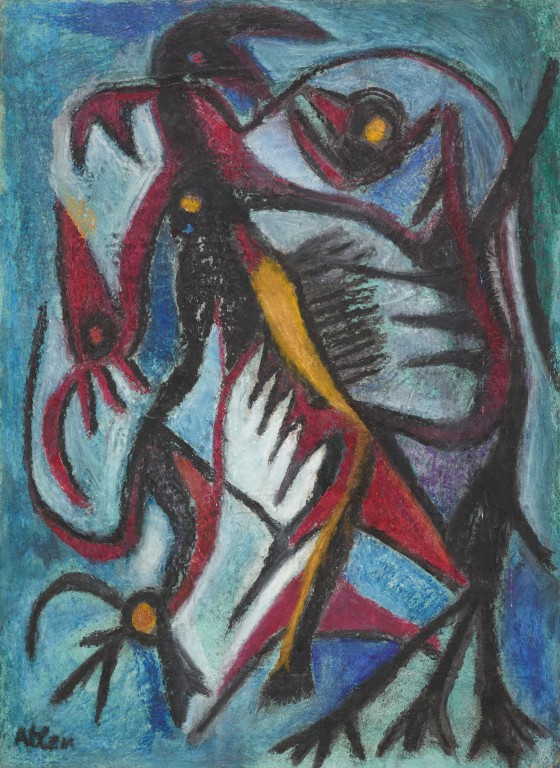
An Artwork Marked by Rhythm
The powerful graphic rhythm of forms is a recurring motif in Atlan's work. The artist was thus constantly searching for a spontaneity to connect him to the "great rhythm of all that is alive"10. According to him, "the true greatness [...] is rhythm, not the superficial rhythm of line but the rhythm that invents forms, the rhythm that a coloured material resists"11. In 1948, he declared in his interviews with writer Aimé Patri: "I admire above all the art of the Dogons, that of the Pre-Colombians and the ancient Assyrians. The forms we invent must be just as capable of 'living' as those found in nature"12. Here, the edges of his figures give rhythm to the drawing’s space in a structured choreography, in the manner of voodoo, jazz or African dances. Through this affirmation of rhythm in his works, Atlan introduces dance, and dance for him is something vital, a passion, a key element of magic. This drawing does indeed make us think of dance, a dance that springs from the deepest sources of our world. Atlan moreover writes that "painting goes much further than we imagine. Primitive men believed they were making magic when they made works of art. And we who believe we are making art are also stirring up infinitely formidable magical forces. This magic is above all rhythm, as it is rhythm that is the origin of breath and life, it is rhythm that invents forms, it is rhythm that injects dance with that something sacred which also animates painting”13.
Jean-Michel Atlan's painting convokes the sacred but, unlike that of Alfred Manessier, for example, which naturally falls within the Catholic Christian faith, it focuses on magical and mystical concerns. His work is in fact built on the depths of the collective unconscious and the symbolism of magical signs. Atlan is like a shaman of post-war painting. In 1958, he said moreover that "[his] magical and mystical preoccupations are found in [his] painting"14, "[his] lines of force would have led [him], in another age, to be a sorcerer or dancer [...] It was not museums that led [him] to [his] vocation as a painter, but shamans"15. Atlan's last letter, shortly before his death, also speaks of his work as an "adventure that makes man grapple with the irreducible forces within and outside him, destiny and nature”16. We grasp then what drew the young CoBrA artists to Atlan's thought and the wild splendour of his painting.
"Painting goes much further than we imagine. Primitive men believed they were making magic when they made works of art. And we who believe we are making art are also stirring up infinitely formidable magical forces." Atlan, November 1959
Atlan, Precursor of CoBrA
Jean-Michel Atlan consistently refused to belong to a school or ideology, which he considered sterilising. In the period after the war, he was one of the abstract painters who distanced himself from the tensions between supporters of abstraction and figuration. At that time, Asger Jorn, a founder of the CoBrA movement (1948-1951), was interested in innovative painters and approached Atlan, one of the most inventive post-war artists who had enjoyed a meteoric rise to fame. Atlan did in fact share the same aim of defining a new approach to painting based on the power of the material and the wellsprings of imagination. Predating the development of this movement by several years, he supported its artists while refusing to join the group (fig. 3).
During one of these informal meetings, Asger Jorn asked Jean-Michel Atlan for texts for the review Cobra. In the sixth issue of 1950, he thus published a short article entitled Abstraction et Aventure dans l'art contemporain (Abstraction and Adventure in contemporary art), in which he goes beyond the differences of opinion of the period. Poet and painter Christian Dotremont saw this article "as a first attempt to define Cobra”17. In it, the artist calls for an art that he defines as an adventure which rejects both "banal realism, a vulgar imitation of reality"18 and "orthodox abstract art, a new academicism"19 that tries to replace living painting by "some more or less decorative arrangement of forms"20. In his view, "the forms that appear the most valid to us today, both in terms of their visual organisation and their expressive intensity, are strictly speaking neither abstract nor figurative. They partake specifically of those cosmic powers of metamorphosis wherein lies the real adventure (from which emerge forms that are themselves and something other than themselves, birds and cacti, abstraction and new figuration)"21.
Throughout his life as a painter, Jean-Michel Atlan tried to rise above the abstraction/figuration debate, virulent in post-World War II Paris and still current in the 1950s and 1960s. He created an art that is uniquely his own, resolutely innovative. In order to dissuade anyone wishing to curb the viewer's imagination with too simple a title, he systematically chose not to give one. "The mystery of [his] birds is precisely that they are not birds”.22 It is indeed easy to discern the various elements and break down into real objects these abstract forms, these fantastic birds, which give the imagination free rein to interpret them. Untitled relates to the abstraction/new figuration that grappled with the vital forces of nature. It heralds the development of the large abstract forms of the monumental compositions begun in the 1950s, when Atlan achieved perfect mastery of his artistic language.
Adeline Lafontaine
Assistant Curator of the Fine Arts collection
Geneva, August 2021
This description benefited from the input of Victor Vanoosten
FGA grant benefactor in 2016
Notes and references
- POLIERI, Jacques, “Les pastels”, in Atlan : catalogue raisonné de l'œuvre complet, [Paris], Gallimard, 1996, pp. 427-589
- Atlan is one of the few artists of modern art to have worked assiduously with pastels - like Redon - and no doubt for the same reasons: for the enigmatic rarity of tone, light and matter they permit.
- A self-taught visual artist, he only began to paint in 1941, at the age of 28.
- Arrested in 1942 for acts of resistance against the occupying forces, Atlan feigned madness and was interned in the psychiatric hospital of Sainte-Anne, where he was protected by Professor Delay, who allowed him to draw and paint on the pretext of therapy.
- He became well-known in 1945 thanks to Gertrude Stein, who purchased numerous examples of his work and introduced him to her collector friends in Paris, London and New York.
- Date of the opening of his first solo exhibition in Paris since 1947 at the Bing Gallery
- Following the exhibition L'Imaginaire at the Galerie du Luxembourg in 1947, organised by Georges Mathieu and Camille Bryen, and especially after the exhibition L'École de Paris at the Galerie Charpentier in 1955, for which he designed the poster.
- Term taken from POLIERI, Jacques, Atlan : catalogue raisonné de l'œuvre complet, p. 178.
- SOLIER, René de, “Visite d’atelier : Atlan”, La Nouvelle Revue Française, No. 10, October 1953, p. 735.
- DOVAL, Bernard, Atlan. Essai de biographie artistique, Paris, Éditions Pierre Tisné, 1962, p. 177
- ATLAN, Jean-Michel, “Les dits du peintre”, in Atlan. Premières périodes 1940-1954, Paris, Éditions Adam Biro, 1989, p. 186
- “Entretien avec Aimé Patri”, in Paru, No. 42, May 1948, p. 56
- Extract of a letter by Atlan addressed to the review Geijutsu Shincho in November 1959 and published in Japanese in December 1959, from ATLAN, Jean-Michel, “Lettre aux amis japonais”, in Atlan. Premières périodes 1940-1954, p. 204.
- ATLAN, Jean-Michel, p. 189
- RAGON, Michel, Le regard et la mémoire : portraits-souvenirs de Atlan, Poliakoff, Dubuffet, Chaissac, Fautrier, Hartung, Paris, Albin Michel, 1997, p. 20
- ATLAN, Jean-Michel, “Lettre aux amis japonais”, p. 199
- LAMBERT, Jean-Clarence, Cobra, un art libre, Paris, Chêne/Hachette, [1983], p. 161
- Ibid.
- Ibid.
- Ibid.
- Cobra, No. 6, Brussels, April 1950, p. 16
- ATLAN, Jean-Michel, “Les dits du peintre”, in Atlan. Premières périodes 1940-1954, p. 192
Bibliography
IIIe Hommage à Atlan, exhibition catalogue [Copenhagen, Salon Corner, 1982], Copenhagen, [n.i.], 1982, No. 12, b/w repr. n. p. (stated dimensions 50 x 70 cm)
COUSSEAU, Henry-Claude; LEVINAS, Emmanuel; POLIERI, Jacques, et al., Atlan, premières périodes 1940/1954, exhibition catalogue [Nantes, Musée des Beaux-Arts, 11.04 – 31.05.1986], Nantes, Musée des Beaux-Arts, 1986, col. repr. p. 86
COUSSEAU, Henry-Claude (dir.), Atlan. Premières périodes, 1940/1954, Paris, Éditions Adam Biro, 1989, col. repr. p. 86 (stated dimensions 50 x 70 cm)
POLIERI, Jacques, Atlan, Catalogue raisonné de l'oeuvre complet, Paris, Éditions Gallimard, 1996, cited p. 445, No. 1040, col. repr. p. 444
DUMAS, Bertrand; SCHUBERT, Yan (dir.), La Libération de la peinture, 1945-1962, exhibition catalogue [Caen, Mémorial de Caen, 14.07.2020 – 31.01.2021], Caen, Mémorial de Caen, 2020, listed p. 166, No. 8, col. repr. p. 57

![Jean-Michel Atlan <br> <em>Sans titre [Untitled]</em> <br>1949 Jean-Michel Atlan](/phpThumb/phpThumb.php?src=/users_uploads/oeuvre_oeuvre_gallery_full/611b615e7c67c.jpg&sx=0&sy=0&sw=3000&sh=2401&w=1680&q=90&aoe=1)
